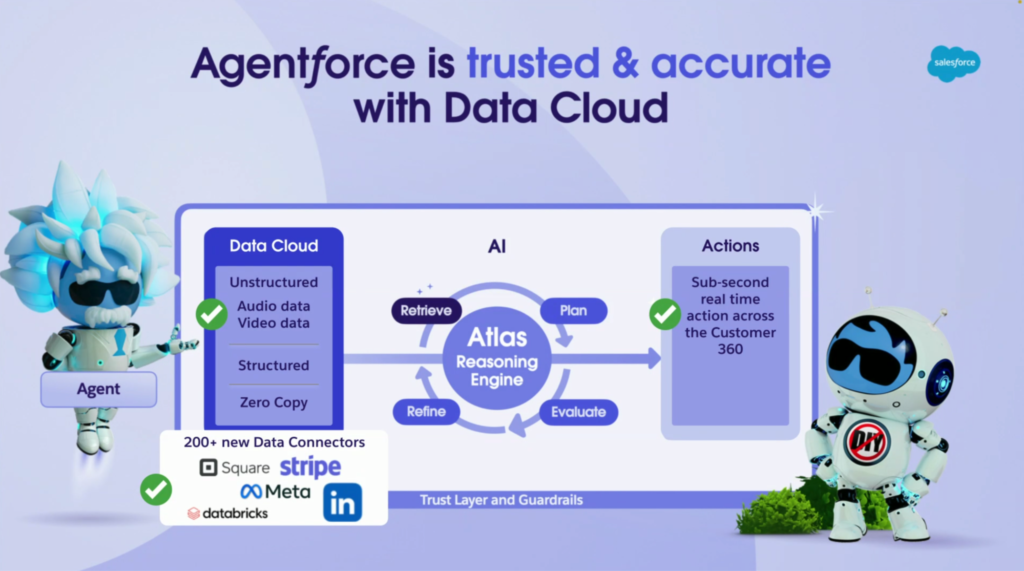Introduction to Salesforce data Cloud
Salesforce Data Cloud is evolving to help businesses incorporate and engage with data more effectively. Recent updates include sub-second data processing, support for a wider array of data formats, and expanded connectors to external systems. These enhancements are designed for organizations that rely on real-time insights, ensuring data is immediately available for action.
In this post, we’ll explore these new functionalities in Salesforce Data Cloud and how they enable faster data management, processing, and integration.
Sub-Second Processing
Sub-second processing is one of the most significant updates in Salesforce Data Cloud. This capability allows data processing to occur in under a second, enabling immediate responses and interactions within applications. For industries like e-commerce, financial services, and customer support, sub-second processing is essential for fast data access.
Value of Sub-Second Processing Outputs
- Real-Time Customer Interactions: Allows personalized experiences by responding instantly to customer actions, such as location-based price adjustments.
- Operational Efficiency: Reduces backend delays, improving process efficiency.
- Better Decision-Making: Provides real-time insights, enabling timely decisions.
Use Cases for Sub-Second Processing
- Retail: Real-time inventory checks and market-driven price updates.
- Financial Services: Live fraud detection through rapid transaction monitoring.
- Customer Service: Instant access to customer records for personalized support.

New Data Formats Supported
Salesforce Data Cloud now supports a wider range of data formats, allowing for greater compatibility across systems and simplified data integration, migration, and analysis.
Newly Supported Data Formats
Supported formats now include JSON, XML, CSV, and more. This flexibility is crucial for organizations aggregating data from various sources, facilitating easier data integration and consolidation.
Advantages of Supporting Multiple Formats
- Simplified Data Integration: Different data formats can be imported without conversion.
- Deeper Insights through Richer Data Analysis: Multiple formats enable more varied data types for analysis.
- Cost Efficiency: Reduces time and cost by minimizing custom data transformation.
Example Use Cases
- Marketing: Aggregating survey data in CSV and social media data in JSON for comprehensive customer profiling.
- Healthcare: Integrating Electronic Health Record (EHR) data in XML and CSV formats.
Improved Connectors for Integration
Salesforce Data Cloud has expanded its library of connectors, facilitating seamless integration with third-party applications, databases, and more.
New Connectors Available
New connectors support popular platforms such as Amazon Web Services (AWS), Microsoft Azure, Google Cloud Platform, and Oracle. These additions make it easy for organizations operating across platforms to access and use data with minimal hassle.
Integration Benefits
- Real-Time Data Sharing: Ensures data consistency and up-to-date information by sharing data between Salesforce and external systems in real time.
- Optimized Data Processes: Automated data transfers reduce manual entry and improve data quality.
- Cross-Platform Insights: Analyzes data across systems for a holistic view of business performance.
Example Use Cases
- Finance: Connect Salesforce to Oracle Financials for consistent, real-time financial data.
- E-commerce: Integrate Salesforce with AWS for live inventory updates and order management.
Benefits and Use Cases of Data Cloud Improvements
The combination of sub-second processing, multi-format support, and expanded connectors empowers organizations to modernize data processes, ensuring faster responses to customer needs, data consistency, and improved data quality.
Example Benefits
- Better Customer Experience: Sub-second processing allows instant responses to customer actions, providing greater personalization.
- Enhanced Operations: New connectors streamline data handling across systems, improving interoperability and efficiency.
- Data Consistency: Multi-format support ensures all data can be seamlessly integrated and analyzed within Salesforce.
Conclusion
Salesforce Data Cloud’s new features—sub-second processing, expanded data format support, and enhanced connectors—are enabling faster, more efficient data handling. These capabilities allow businesses to process data in real-time, integrate with other platforms, and gain insights from diverse data sources.
By leveraging these features, organizations can optimize data management and drive business growth with speed and precision. Explore Salesforce Data Cloud’s latest enhancements to see how they can transform your data processes.